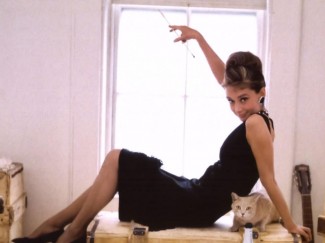Breakfast At Tiffany’s (Blake Edwards, 1961): USA
Reviewed by Sofia Nagel. Viewed on DVD.
In Breakfast at Tiffany’s, Holly Golightly (Audrey Hepburn) evades her murky past by adopting a glamorous, new identity. There are many beautiful and witty protagonists yet what differentiates Holly is her extreme sadness. Holly is in a constant battle between stability and freedom. She’s attempting to escape from reality, from people, and places. She’s even in denial of her own identity. She adopts the name of “Holiday Golightly,” encapsulating her desire to avoid stability by believing life is a mere holiday, that one can just simply abandon relationships and responsibilities when they threaten to jeopardize her independence. When Paul first sees Holly in distress and inquires what the matter is, she asks if he knows what the “mean reds” are. Paul asks if they’re similar to having the blues. “No, the blues are because you’re getting fat or maybe it’s been raining too long. You’re sad, that’s all. But the mean reds are horrible. You’re afraid and you sweat like hell, but you don’t know what you’re afraid of. Except something bad is going to happen, only you don’t know what it is.” Paul (George Peppard) or Fred as Holly likes to call him, asks what she uses as a cure,”what I’ve found does the most good is just to get into a taxi and go to Tiffany’s,” Holly says. Her sweet innocence and search for a home are revealed. Her naivety of the world is made evident. “It calms me down right away, the quietness and the proud look of it; nothing very bad could happen at Tiffany’s.”
Holly Golightly is an incredibly sad character. She’s also very complex. Holly does not love herself, therefore not allowing anyone to love her. Her instability and inability to deal with reality are heavily pressed on in the film. Holly has no tangible goals – she has a vision for what she wishes her life to be like but is too afraid to go forward. In this sense, the film does not appear to follow Hollywood classical conventions but rather follows an Art Cinema aesthetic.
Breakfast at Tiffany’s represents an era that many still continue to mimic and were inspired to from the film. Breakfast at Tiffany’s was also very progressive for its time. The author, Truman Capote, originally wanted Marilyn Monroe to star as Holly Golightly but she was unable to because of a film conflict and also was under the advice that acting as a ditsy call girl wasn’t in the best interest for her image. As tormented as she is and despite her at times silly decisions, Holly remains a survivor and independent.
About this entry
You’re currently reading “Breakfast At Tiffany’s (Blake Edwards, 1961): USA,” an entry on Student Film Reviews
- Published:
- 07.13.13 / 6am
- Category:
- Academic Papers, DVD, Films

53 Comments
Jump to comment form | comments rss [?] | trackback uri [?]